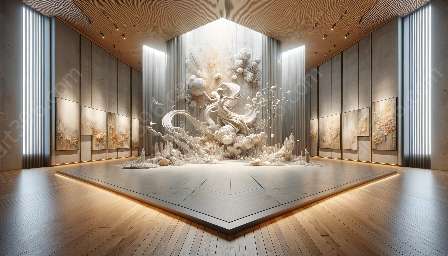Site-specific art installations are a significant form of artistic expression, intimately connected to the spaces and environments in which they are created. These installations often exist transiently, altering and enhancing the relationship between art, space, and viewers. Documentation plays a crucial role in capturing and preserving the essence of these artworks, and technology has revolutionized the way in which these installations are documented, shared, and perpetuated.
Understanding Site-Specific Art Installations
Site-specific art installations are artworks that are created or displayed in a particular location, considering the site's characteristics, history, and context. Artists immerse themselves in the space, drawing inspiration from its physical and cultural elements, and create installations that engage with their surroundings in a unique and thought-provoking manner. These installations are temporary by nature, often existing for a specific period before being dismantled or modified.
One of the defining features of site-specific art installations is their relationship with the site and the specific experiences they evoke in viewers. They challenge traditional notions of art display by defying the confines of traditional gallery spaces and engaging with diverse landscapes, urban environments, or historical sites.
The Importance of Documentation
Documentation is essential for preserving the existence, impact, and meaning of site-specific art installations. As these artworks are often ephemeral, documentation serves as a means of capturing their essence, allowing them to be experienced beyond their physical presence. It also enables artists to communicate their vision and message to a broader audience, transcending geographical and temporal boundaries.
Through documentation, the intricate details of site-specific art installations, such as the creative process, materials used, and the relationship with the site, can be recorded for posterity. This not only facilitates the conservation of the artworks but also contributes to the scholarly and historical understanding of contemporary art practices.
The Impact of Technology
Technology has significantly transformed the documentation of site-specific art installations, offering innovative solutions for recording, archiving, and sharing these unique creations. Advancements in digital photography, videography, augmented reality (AR), virtual reality (VR), and interactive media have opened up new avenues for capturing the immersive nature of site-specific installations.
Digital photography and videography allow for high-quality, detailed documentation of art installations, preserving their visual intricacies and spatial relationships with precision. These mediums enable viewers to revisit the installations virtually, gaining insights into the artist's intentions and the site-contextual dialogue embedded within the artworks.
Furthermore, augmented reality and virtual reality technologies have revolutionized the way audiences interact with site-specific art installations. Through AR and VR experiences, individuals can engage with these artworks in immersive and interactive ways, transcending physical and geographical constraints. This allows for a deeper and more nuanced appreciation of the installations, fostering a heightened sense of connection and understanding.
Interactive media platforms provide artists with the means to create digital archives that not only document their installations but also offer supplementary content, such as artist interviews, behind-the-scenes footage, and contextual information. These platforms serve as comprehensive resources that enrich the audience's understanding of the artworks and the artists' creative processes.
Preservation and Legacy
Technology plays a pivotal role in the preservation and perpetuation of site-specific art installations, ensuring that their impact endures beyond their physical presence. Digital archives, online exhibitions, and interactive experiences enable these artworks to be accessible to a global audience, transcending temporal and spatial constraints. Moreover, technological advancements facilitate the conservation of documentation, safeguarding the legacy of site-specific installations for future generations.
The Intersection of Technology and Art Installation
The seamless integration of technology into the documentation of site-specific art installations reflects the evolving nature of contemporary art practices. It underscores the symbiotic relationship between technology and artistic expression, highlighting the potential for innovation, engagement, and accessibility within the art world.
Furthermore, the utilization of technology in documenting art installations has the potential to redefine the traditional boundaries of art, enabling a more inclusive and diverse audience to engage with and appreciate these immersive and site-specific artworks. It fosters a democratization of art, breaking down barriers to access and inviting broader participation in the artistic discourse.
Conclusion
The role of technology in the documentation of site-specific art installations is integral to the preservation, dissemination, and evolution of these unique artistic expressions. Through innovative technological tools and platforms, the essence and impact of site-specific installations can be captured, shared, and celebrated on a global scale. As technology continues to advance, its synergy with art installations holds the promise of enriching the artistic landscape, fostering deeper connections between artists, audiences, and the spaces that inspire them.

